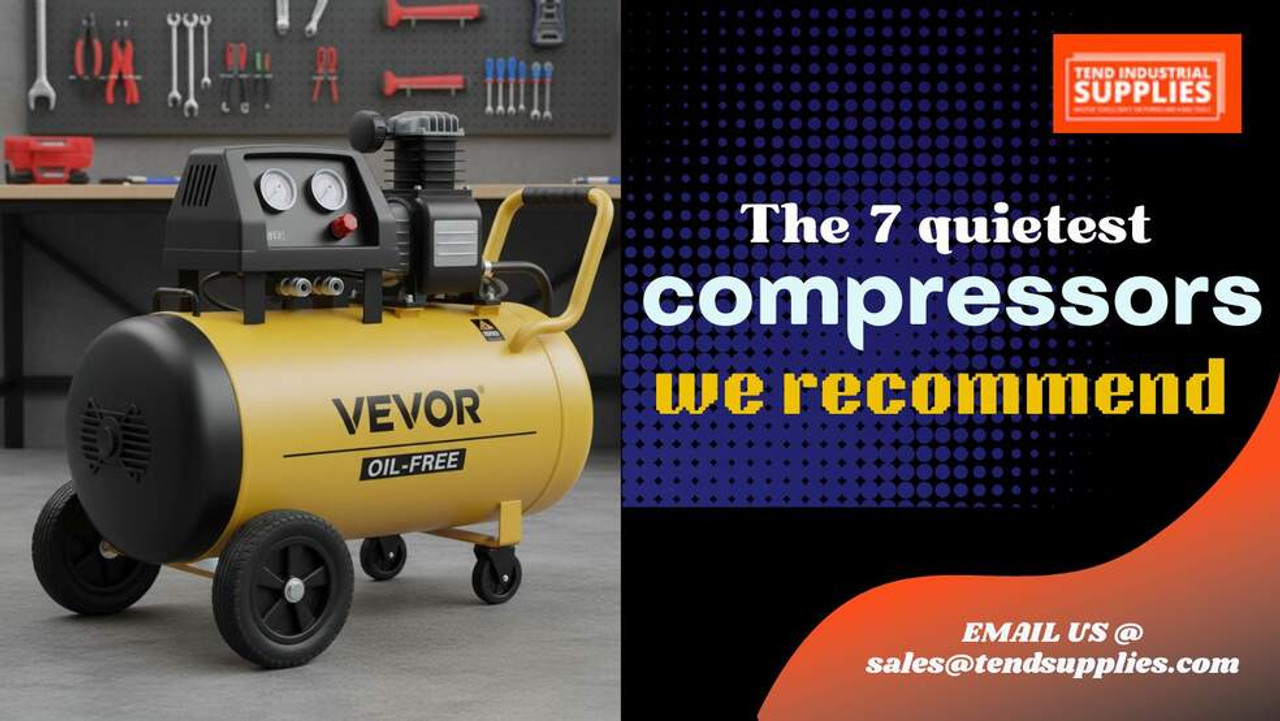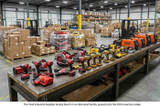Top 7 Quietest Air Compressors for Home & Workshop Use in 2025
Key Takeaway
For truly indoor-friendly performance, target compressors rated ≤60 dB and match CFM @ 90 PSI to your tools: 1–2 CFM for nailers/airbrushing, 2–3 CFM for light DIY, and higher-CFM units (e.g., 10-gal class) for more demanding tasks. California Air Tools stands out for ultra-quiet, oil-free designs that keep noise low and maintenance simple—perfect for home shops and small workshops. If you want true “indoor-friendly,” look for compressors rated ≤60 dB(A) for light/medium work (trim, brad/finish nailers, inflation) and ~70 dB(A) for higher-CFM tasks. CAT’s 56–60 dB models are among the quietest you can actually use in a home workshop.
If you’re setting up a garage or small shop, “quiet” isn’t a luxury—it’s safety, focus, and fewer neighbor complaints. We tested the market’s top ultra-quiet options and picked seven standouts that balance low noise with real-world performance. For easy buying, we spotlight several California Air Tools (CAT) models—industry leaders in low-dB, oil-free designs—and include a couple of credible alternatives for comparison.
How we chose
- Noise (dB A): Verified manufacturer specs at 1 meter.
- Usable airflow: CFM @ 90 PSI for tool compatibility.
- Capacity & portability: Tank size vs. weight/footprint.
- Low maintenance: Oil-free pumps are preferred for clean air and easier ownership.
Quick picks (by use case)
- Quietest ultra-portable: CAT 1P1060S, 56 dB, 1 gal — trim, brad, inflating.
- Best all-around for DIYers: CAT 8010, 60 dB, 8 gal — versatile capacity with indoor noise.
- Lightweight aluminum tank: CAT 2010A, 60 dB, 2 gal — easy to carry, rust-free
- Twin-stack precision work: CAT 4610AC, 60 dB, 4.6 gal — stable output, compact footprint.
- Bigger jobs, still “quiet”: CAT 10020C, 70 dB, 10 gal — more CFM for air-hungry tools.
- Non-CAT alternative (proven): Makita MAC210Q, 60 dB, 2 gal — Quiet Series, 2.0 CFM @ 90 PSI.
- Budget quiet competitor: Stealth SAQ-1234, 60 dB, 2 gal — 1.8 CFM @ 90 PSI.
The 7 quietest compressors we recommend (2025)
1) California Air Tools 1P1060S — 56 dB, 1 gal, 1.2 CFM @ 90 PSI
The quiet champ for light duty. At 56 dB, it’s quieter than normal conversation and perfect for apartments, trim work, airbrushing, and inflating. Oil-free pump, fast recovery, truly grab-and-go.
Best for: ultra-portable, indoor-only tasks.
2) California Air Tools 8010 / 8010A — 60 dB, 8 gal, ~2.2 CFM @ 90 PSI
Our favorite “do-most-things” quiet pick. At 60 dB with an 8-gallon tank, it balances noise, capacity, and portability. Choose 8010A for rust-free aluminum.
Best for: homeowners and makers who want one quiet compressor that handles day-to-day jobs.
3) California Air Tools 2010A — 60 dB, 2 gal, 2.2 CFM @ 90 PSI
A super-portable aluminum-tank unit (≈35 lb) that’s easy to stash on a shelf. Great when you need a CAT quiet but don’t need an 8-gallon footprint.
Best for: mobile work, quick indoor tasks, trim and finish nailers.
4) California Air Tools 4610AC — 60 dB, 4.6 gal, 2.2 CFM @ 90 PSI
Twin-stack stability with CAT’s quiet DNA. The aluminum tanks keep the weight reasonable while the layout gives a low center of gravity.
Best for: bench work, small shops, and anyone who wants steadier output than 1–2 gal units.
5) California Air Tools 10020C — 70 dB, 10 gal, 5.3 CFM @ 90 PSI
Need more air for blow-guns, die grinders, or faster recovery—but still want “quiet”? The 10020C’s 2.0 HP pump delivers legit airflow while holding noise to ~70 dB (well below typical 80–90 dB shop units).
Best for: bigger DIY projects and small-shop workloads that would overwhelm 1-HP units.
6) Makita MAC210Q Quiet Series — 60 dB, 2 gal, 2.0 CFM @ 90 PSI
A respected non-CAT option. Makita’s Quiet Series runs ~60 dB, offers 2.0 CFM @ 90 PSI, and a 135 PSI max for trim/finish tools.
Best for: buyers already in the Makita ecosystem who want a quiet, compact unit.
7) Stealth SAQ-1234 — ≈60 dB, 2 gal, 1.8 CFM @ 90 PSI
A value alternative with legitimately low noise claims and adequate airflow for nailers and inflation. Good for casual users on a budget.
Best for: budget-minded DIYers who still want “quiet.”
Want whisper-quiet at any size? CAT’s Sound-Proof Cabinet models enclose the compressor and drop noise to around 40 dB—library-level quiet. See 8010SPCAD and 10020SPC families.
Comparison snapshot
|
Model |
Noise |
Tank |
CFM @ 90 PSI |
Why it stands out |
|
CAT 1P1060S |
56 dB |
1 gal |
1.2 |
Quietest portable option for light tasks. c |
|
CAT 2010A |
60 dB |
2 gal (Aluminum) |
2.2 |
|
|
CAT 4610AC |
60 dB |
4.6 gal (Aluminum) |
2.2 |
|
|
CAT 8010 / 8010A |
60 dB |
8 gal |
~2.2 |
|
|
CAT 10020C |
70 dB |
10 gal |
5.3 |
|
|
Makita MAC210Q |
60 dB |
2 gal |
2.0 |
|
|
Stealth SAQ-1234 |
~60 dB |
2 gal |
1.8 |
This is a budget quiet pick. |
Buying tips (fast)
- Match CFM to tools: Nailers & inflation ≈ 1–2 CFM @ 90; grinders/sanders need more—consider 10020C-class.
- Oil-free = cleaner air: Better for finishing work and less maintenance. (All picks above are oil-free.)
- Aluminum tanks fight rust: Look for “A/ALFC/AC” in CAT model names.
- Noise context: ~60 dB ≈ normal conversation; 70 dB is still “quiet” compared to many shop units.
FAQs
1) What decibel (dB) level counts as “quiet” for air compressors?
Generally, around 60 dB is considered quiet—about normal conversation at 1 meter. That’s a night-and-day difference from traditional shop units (often 80–90 dB).
2) Can a quiet compressor still run my tools?
Yes—just match CFM @ 90 PSI to your tools. Nailers, staplers, airbrushes, and inflation usually need ~1–2 CFM; light sanding/grinding or continuous use needs more air (step up to higher-CFM, larger-tank models).
3) Oil-free vs. oil-lubricated: which is better for home workshops?
For indoor DIY and finish work, oil-free is ideal: cleaner air, less maintenance, and no oil mist. Modern oil-free, dual-piston pumps (like many CAT units) are engineered to be both quiet and durable.
4) Does an aluminum tank make a difference?
Functionally similar air output, but aluminum tanks are lighter to move and won’t rust—great for garages/basements. Noise is driven more by pump/motor design than by tank material.
5) How can I reduce compressor noise even further?
Place the unit on an anti-vibration mat, avoid hard reflective corners, use short, proper-gauge power cords, and consider sound-enclosure cabinet models when you need near-library levels. Also keep fittings tight—air leaks hiss and add perceived noise.









